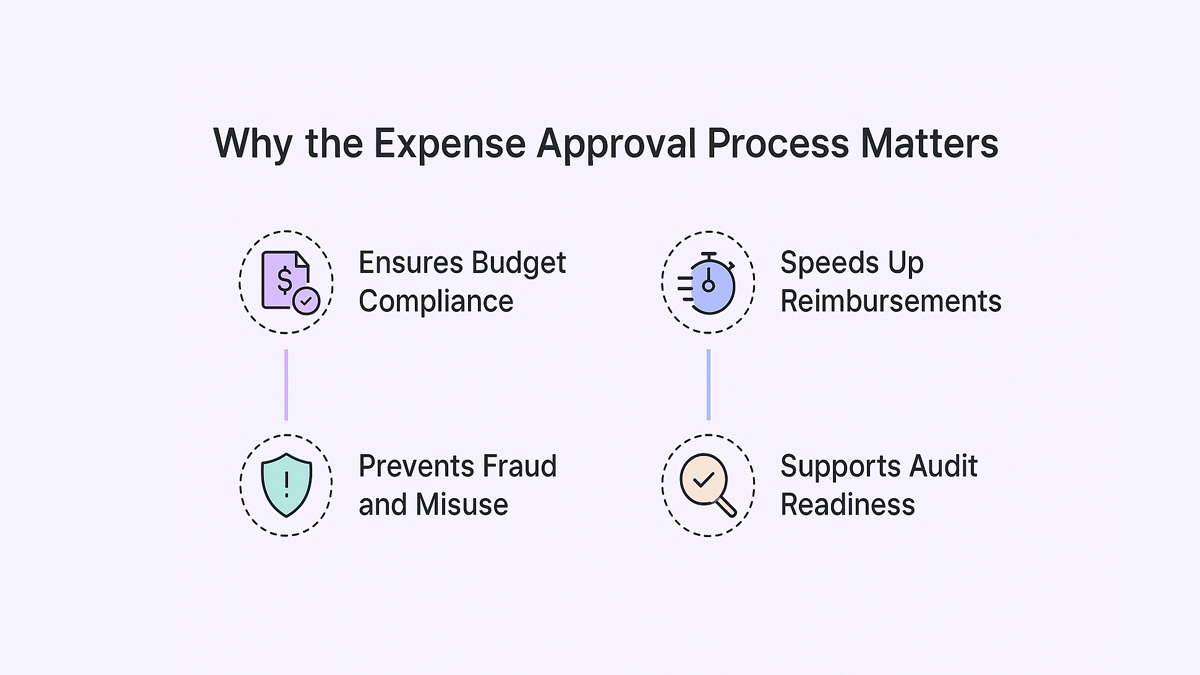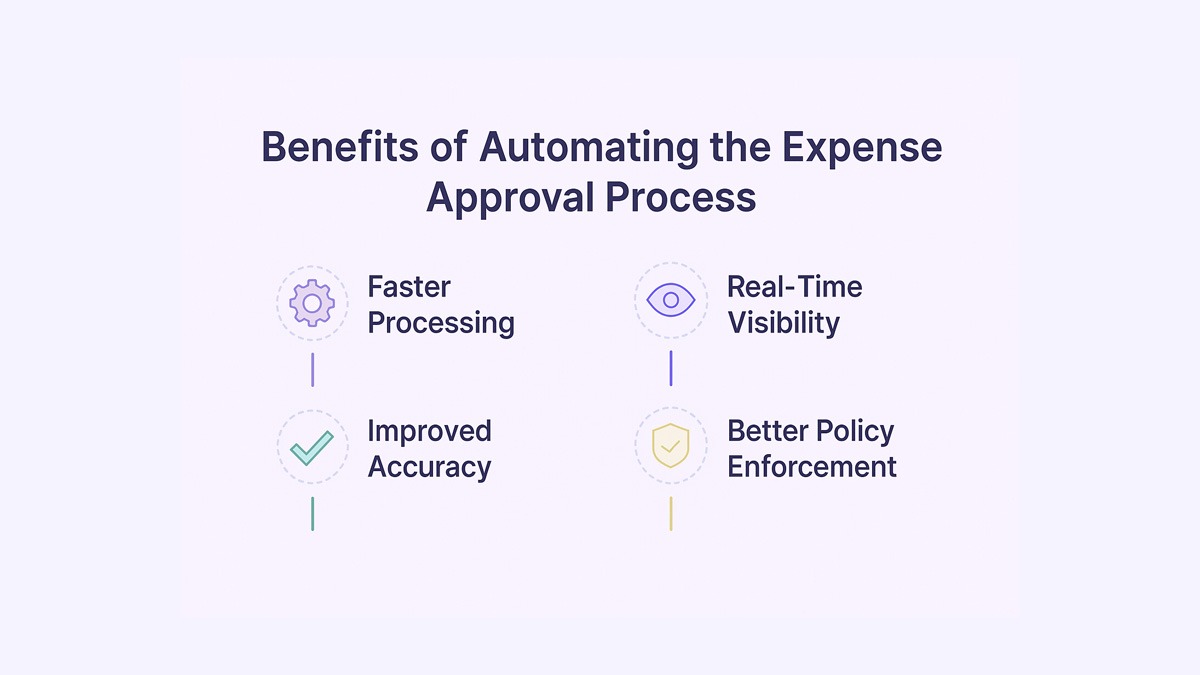

The Expense Approval Process No One Tells You About (But Should)

The Expense Approval Process No One Tells You About (But Should)
Fix your broken expense approval process with automation tips and best practices to speed up reviews and improve compliance.


In a fast-moving business world, spending happens quickly - and sometimes, without enough control. Whether it’s a sales rep booking a last-minute flight or a manager picking up software subscriptions, unchecked expenses can quietly drain budgets. That’s where a solid expense approval process steps in, turning financial chaos into control and accountability.
What this blog covers:
- What is the expense approval process?
- Why the expense approval process matters
- Examples of expense approvals
- Common problems in expense approval and reimbursement
- Benefits of automating the expense approval process
- How to automate the steps in the expense approval process
- Choosing the right expense approval tools
- How Spendflo helps with expense management automation
- Frequently asked questions on the expense approval process
What is the Expense Approval Process?
The expense approval process is a structured workflow that ensures employee spending is reviewed and authorized before reimbursement or payment. It typically involves submitting expense reports, verifying policy compliance, and getting approvals from designated managers or finance teams.
Why the Expense Approval Process Matters
A well-defined expense approval process isn’t just red tape - it’s a financial safeguard. It protects your budget, supports compliance, and helps teams spend smarter without slowing them down. Below are key reasons why businesses can’t afford to overlook it.

Ensures Budget Compliance
When employees have the freedom to spend without checks, it’s easy to drift off course. A structured approval flow helps ensure every expense aligns with pre-set budgets and priorities. Managers can catch out-of-policy or unnecessary spending before it hits the books, keeping departments financially on track. This adds an extra layer of control to overall budget management efforts.
Prevents Fraud and Misuse
It only takes one unchecked expense claim to trigger a major compliance issue. By requiring
documentation and multiple approval steps, organizations can weed out duplicate claims, inflated reimbursements, or entirely fraudulent submissions. This level of oversight is key to maintaining strong financial control across teams. This protects the business from both internal and external risks.
Speeds Up Reimbursements
Ironically, structure often brings speed. When approval paths are clearly mapped and automated, finance teams don’t waste time chasing receipts or clarifying vague entries. Employees get paid back faster, and finance can close books more efficiently. This also helps reduce the need for frequent cash advances, improving liquidity control.
Supports Audit Readiness
Whether it’s a routine audit or a surprise review, clean records matter. A formal expense approval process ensures all expenses are logged, traceable, and compliant with company policy. This not only makes audits smoother - it also helps defend spending decisions when questioned.
Examples of Expense Approvals
Not all expenses are created equal. From everyday office supplies to high-ticket travel costs, different types of spending require different levels of scrutiny. Here are common categories where a well-structured expense approval process makes all the difference:
Employee Travel and Lodging
Flights, hotels, car rentals - these are often among the most expensive and frequent claims. Managing travel expenses efficiently can prevent over-budgeting and improve forecasting. Approvals help ensure travel is necessary, booked within company policy, and cost-effective. It also allows finance teams to track how much is being spent on travel overall.
Client Entertainment
Dinners, events, and gifts tied to client engagement often blur the lines between personal and professional spending. Approvals here help avoid policy violations and ensure that expenses align with business outcomes.
Office Supplies
While small in value, office expenses can pile up quickly if not monitored. Approval workflows help track recurring purchases and flag excessive or redundant items, especially when multiple teams are involved. Each claim should be matched to the actual expense incurred to maintain accuracy.
Training and Education Expenses
Employees often request reimbursement for courses, certifications, or conferences. A clear approval process confirms the training is relevant and pre-approved - preventing reimbursement conflicts later on.
Common Problems in Expense Approval and Reimbursement
Even with the best intentions, manual or poorly structured expense approval processes can quickly spiral into frustration. From slow turnaround times to policy breaches, here are some of the most common issues teams face - and why they signal a need for change.
Delayed Approvals
Expenses often get stuck in limbo because managers are traveling, unclear on policy, or simply forget to review them. These delays frustrate employees waiting for reimbursements and create unnecessary end-of-month crunch for finance teams trying to close books on time. Delayed payments may even lead to missed early payment discounts or increased interest rates.
Policy Violations
Without automated checks in place, it’s easy for employees to submit claims that fall outside company policy - like booking first-class travel or exceeding meal limits. These violations often slip through unnoticed, especially in companies handling dozens or hundreds of claims each month.
Lack of Visibility
Manual spreadsheets and email threads don’t provide a real-time view of who’s spending what. Finance teams struggle to track open approvals, pending reimbursements, or historical expense trends, leading to surprises at the end of the quarter. Automated expense reporting provides a clear audit trail and simplifies month-end reviews.
Manual Errors
Copy-paste mistakes, missed receipts, or incorrect amounts are more common than you’d think. Manual data entry increases the risk of human error, which can slow down reimbursements and skew reporting accuracy.
Benefits of Automating the Expense Approval Process
Automating your expense approval process isn’t just about saving time - it’s about transforming how your finance function operates. When approvals are no longer buried in inboxes or spreadsheets, everything runs smoother, faster, and with fewer errors.

Faster Processing
Automation routes expense requests to the right approver instantly, cutting out delays caused by manual handoffs. Employees don’t have to guess who to send expenses to - it’s handled by the system, so nothing gets lost in the shuffle. Real-time notifications keep both submitters and approvers updated on progress.
Improved Accuracy
Automated checks flag missing receipts, incorrect totals, or out-of-policy expenses before they even reach approvers. Most tools also require users to upload a valid proof of purchase with each claim. This reduces back-and-forth and ensures that finance teams receive clean, policy-compliant data.
Real-Time Visibility
With automation, finance leaders gain real-time dashboards that track pending, approved, and reimbursed expenses. This visibility supports better forecasting and budget tracking, all without digging through emails or chasing updates. Real-time data also aligns with Accrual Accounting practices for accurate financial reporting.
Better Policy Enforcement
Built-in policy rules ensure that expenses outside company guidelines are flagged or rejected automatically. This keeps teams accountable and ensures compliance without needing to micromanage every claim.
How to Automate the Steps in the Expense Approval Process
Automation isn’t just a tech upgrade - it’s a mindset shift in how approvals are managed. Here’s how to break down and automate each step for smoother, faster, and more compliant expense handling.
Create a Clear Expense Policy
Start with a solid foundation. Define what qualifies as a reimbursable expense, set limits for different categories, and outline the approval chain. This policy should be accessible to all employees and easy to reference within your automation tool.
Use Automated Approval Workflows
Implement a system where expense reports are automatically routed to the right approvers based on criteria like amount, department, or type of spend. Clear expense report approval logic helps avoid backlogs and ensures timely reimbursement. This eliminates manual forwarding and ensures nothing falls through the cracks.
Integrate With Financial Systems
Connect your expense approval tool to accounting or ERP software. This helps ensure alignment between employee spending and accounts payable workflows. This ensures that once an expense is approved, it flows directly into your financial records - no duplicate data entry, no delays.
Enable Mobile Submissions
Let employees submit expenses on the go by uploading receipts and filling out claims from their phones. The mobile system can also capture tracking information for physical receipts or shipments. This speeds up submissions and reduces the chance of lost receipts or delayed filing.
Choosing the Right Expense Approval Tools
Not all expense tools are created equal. The right platform should do more than just digitize - it should simplify, streamline, and scale with your needs. Choosing a reliable expense management software can reduce overhead and boost compliance. Here’s what to look for when choosing a tool to automate your expense approval process.
Ease of Integration
Your tool should seamlessly connect with existing systems like accounting software, payroll, or ERP platforms. The smoother the integration, the less manual work for your finance team and the fewer data mismatches down the line.
Customizable Workflows
Every organization has its own approval rules. Choose a tool that lets you set conditional workflows - like multi-level approvals for high-value expenses or department-specific approvers - to match your internal structure. Advanced tools also support delegation permissions for temporary approvers.
User-Friendly Interface
If your team dreads using the software, they won’t use it properly. Look for intuitive dashboards, drag-and-drop interfaces, and mobile accessibility to make adoption quick and painless for employees and managers alike.
Real-Time Reporting and Analytics
Beyond approvals, your tool should offer insights. Many platforms also offer integrations with corporate cards for seamless expense tracking. Real-time data on expense categories, trends, and employee habits helps finance leaders make better budgeting and policy decisions. This includes visibility into specialized spending such as subaward invoices in research or grant-heavy organizations.
How Spendflo Helps With Expense Management Automation
Spendflo simplifies and streamlines the expense approval process by giving finance and procurement teams a centralized, real-time view of all SaaS and vendor-related expenses. With automated workflows, custom approval paths, and spend visibility baked into the platform, businesses can eliminate manual tracking, reduce approval delays, and enforce policies with ease. Spendflo’s deep integration with procurement operations ensures that expense management isn’t just efficient - it’s also aligned with your broader financial goals and vendor strategy.
Frequently Asked Questions on the Expense Approval Process
What are the key benefits of automating expense approvals?
Automation speeds up processing, improves accuracy, and ensures policy compliance. It also reduces manual errors, saves time for finance teams, and gives real-time visibility into spending trends.
How can businesses prevent fraud in expense claims?
By implementing a clear policy, using automated checks for policy violations, and requiring documentation for every claim, businesses can catch and prevent fraudulent or duplicate submissions early.
Which expenses typically require approval?
Commonly approved expenses include travel, meals, office supplies, software subscriptions, training costs, and client-related entertainment. Anything that impacts budgets or falls outside standard allowances should be reviewed.
What should an ideal expense policy include?
A strong policy outlines reimbursable and non-reimbursable items, spending limits, documentation requirements, and approval workflows. It should also include timelines for submission and reimbursement to set clear expectations.
What tools support expense compliance and approval hierarchy for modern finance teams?
Tools that include built-in expense compliance checks and customizable approval hierarchy workflows help ensure spending stays within policy and is reviewed by the right people. These features also support better.
How do cloud-based portals and expense management apps simplify tracking and reporting?
A cloud-based portal paired with an expense management app makes it easy to track submissions, view real-time updates, and store documentation. Employees can upload receipts instantly, and finance teams can monitor claims from anywhere.










.png)




.png)










.avif)





